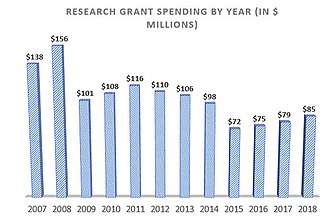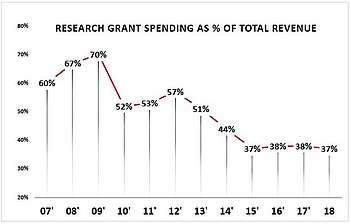JDRF
JDRF is a nonprofit 501(c)(3) organization that funds type 1 diabetes (T1D) research, provides a broad array of community and activist services to the T1D population and actively advocates for regulation favorable to medical research and approval of new and improved treatment modalities. It was initially founded as the JDF, the Juvenile Diabetes Foundation. It later changed its name to the Juvenile Diabetes Research Foundation and is now known as JDRF.
.png) | |
| Founded | May 28, 1970[1] |
|---|---|
| Founder | Lee Ducat, Carol Lurie |
Tax ID no. | 23-1907729[2] |
| Legal status | 501(c)(3) nonprofit organization[3] |
| Location |
|
| Method | Research funding, Political advocacy, Education |
| Subsidiaries | JDRF Theraputics Fund LLC[2] |
Revenue (2016) | $204,355,782[2] |
| Expenses (2016) | $189,479,405[2] |
| Endowment | $7,176,427[2] |
Employees (2015) | 890[2] |
Volunteers (2015) | 300,000[2] |
| Website | jdrf |
Formerly called | Juvenile Diabetes Research Foundation |
History
JDRF was founded to find a cure for juvenile diabetes; in the 2000s it broadened its research efforts to include ways to better manage the disease and ways to prevent it.[4]
In 2005 the board of JDRF committed to supporting work on medical devices to manage blood glucose, known as artificial pancreas technology. The Board was urged to do so by Jeffrey Brewer, who had founded and sold Citysearch and had become intensely interested in juvenile diabetes and medical devices after his son was diagnosed with the condition.[5] The project brought together academic researchers and medical device companies. The focus was on integrating continuous glucose monitors (CGM's) and insulin pumps via a computerized program that would use blood glucose levels obtained through the CGM to calculate an insulin dosage to be dispensed through the insulin pump.[6][7] The first such device was approved in 2016.[8]
JDRF has advocated for stem cell research; in a 2004 article in The Wall Street Journal, the authors observed that the JDRF "... has become adept at unleashing an army of hard-to-resist lobbyists – made up of determined parents and their afflicted children – on researchers, politicians and potential donors."[9]
In 2011 the FDA had made it a priority to clarify the requirements for approval for such a closed-loop monitoring and drug delivery device for T1D, and in 2011 announced it was preparing draft guidelines. JDRF launched a campaign to influence those guidelines to be lenient.[6] After the first closed loop device was approved in 2016, JDRF lobbied insurance companies to cover it.[10] It also put resources into educating people with diabetes on how to navigate health insurance in the United States, and into lobbying Congress to continue funding diabetes research through the NIH.[10]
The FDA lobbying campaign was part of a gradual realignment of the organization to focus on issues other than helping find a cure for JD, to helping treat and manage it. This broadened scope meant that the organization increasingly directed its funds to education and advocacy, along with research funding.[4] This including lobbying insurance companies to pay for continuous glucose monitor devices and educating patients how to advocate for themselves, and lobbying Congress for more NIH funding.[11]
The UK arm of the Juvenile Diabetes Foundation (JDRF) was founded by Richard Lawson in 1986. In 1988 he became Director. The Foundation is now known as the Juvenile Diabetes Research Foundation (JDRF) and is "the leading global organisation funding Type 1 Diabetes research". Richard remained a Director until 1997, but he and his wife Jane became Patrons of the charity in 2009 and continued to support it.
Research
In 2018, JDRF provided $85 million (37% of their total income) to T1D scientific research grants, they provided $156.4 million (67% of their total income) in 2008.[12]
See also
- Juvenation
- Taste of Tennis, a donor
References
- "JDRF International". Pennsylvania Department of State. Retrieved September 27, 2017.
- "Form 990: Return of Organization Exempt from Income Tax". JDRF International. Guidestar. June 30, 2016.
- "JDRF". Exempt Organizations Select Check. Internal Revenue Service. Retrieved September 27, 2017.
- Insel, RA; Deecher, DC; Brewer, J (January 2012). "Juvenile Diabetes Research Foundation: mission, strategy, and priorities". Diabetes. 61 (1): 30–5. doi:10.2337/db11-1398. PMC 3237656. PMID 22187372.
- "Robotic Pancreas: One Man's Quest to Put Millions of Diabetics on Autopilot". Wired Magazine, April 19, 2010. Retrieved 10 May 2013.
- Dolgin, E (17 May 2012). "Medical devices: Managed by machine" (PDF). Nature. 485 (7398): S6–8. doi:10.1038/485s6a. PMID 22616096.
- "Artificial Pancreas Gives Girl a Vacation from Diabetes". CNN, March 4, 2012. Retrieved 10 May 2013.
- Robbins, Rebecca (3 October 2016). "The risky bet behind the first 'artificial pancreas' for diabetes". STAT.
- Regalado, A; Waldholz, M (31 March 2004). "Ballot drive puts stem-cell funding in voters' hands. In California, diabetes groups show growing influence as they push for research; big backing from Hollywood". Wall Street Journal (Eastern Ed.): A1, A12. PMID 15250089.
- Hoskins, Mike (December 7, 2017). "JDRF Gets Aggressive on Better Diabetes Insurance Coverage". Healthline.
- Hoskins, Mike (December 7, 2017). "JDRF Gets Aggressive on Better Diabetes Insurance Coverage". Healthline.
- http://thejdca.org/2019-jdrf-research-grant-allocation
- https://projects.propublica.org/nonprofits/organizations/231907729
- http://thejdca.org/2018-jdrf-financials

